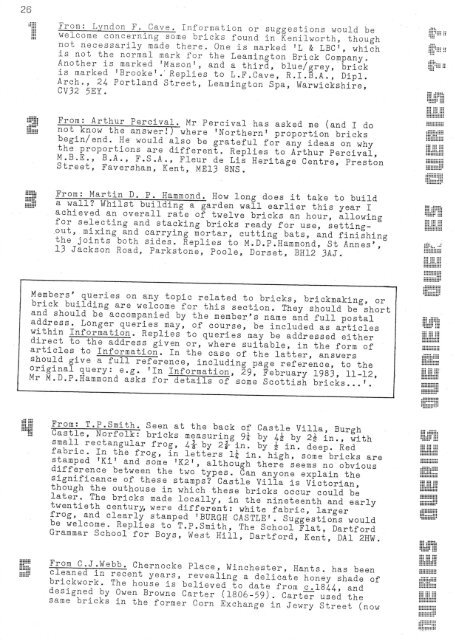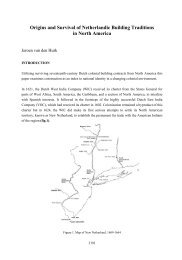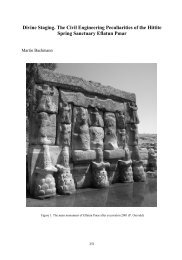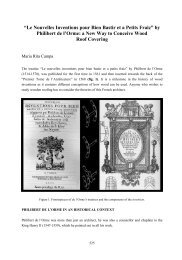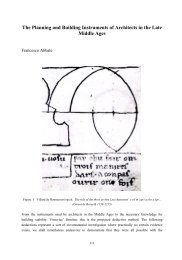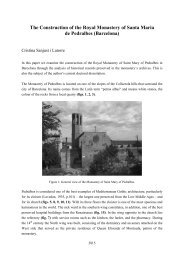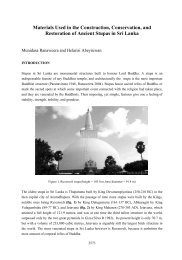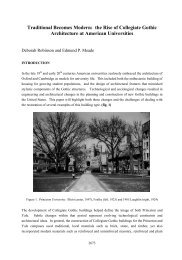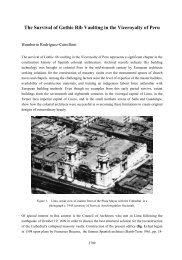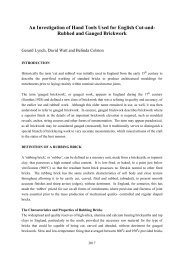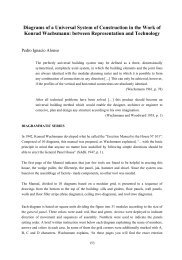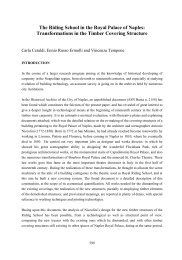bricks from the - Department of Architecture
bricks from the - Department of Architecture
bricks from the - Department of Architecture
You also want an ePaper? Increase the reach of your titles
YUMPU automatically turns print PDFs into web optimized ePapers that Google loves.
26<br />
:::<br />
:::<br />
From: Lyndon F. Cave. Information or suggestions would be<br />
welcome concerning some <strong>bricks</strong> found in Kenilworth, though<br />
not necessarily made <strong>the</strong>re. One is marked 'L & LBC', which<br />
is not <strong>the</strong> normal mark for <strong>the</strong> Leamington Brick Co~pany.<br />
Ano<strong>the</strong>r is marked 'Mason', and a third, blue/grey, brick<br />
is marked 'Brooke'.' Replies to L.F.Cave, R.I.B.A., Dipl.<br />
Arch., 24 Portland Street, Leamington Spa, Warwickshire,<br />
CV32 5EY.<br />
From: Arthur Percival. Mr Percival has asked me (and I do<br />
not know <strong>the</strong> answer!) where 'Nor<strong>the</strong>rn' proportion <strong>bricks</strong><br />
begin/end. Ha would also be grateful for any ideas on why<br />
<strong>the</strong> proportions are different. Replies to Arthur Percival,<br />
M.B.E., B.A., F.S.A., Fleur de Lis Heritage Centre, Preston<br />
Street, Faversham, Kent, ME13 8NS.<br />
:::::::::::<br />
::::::::Hi<br />
H:::::::::<br />
From: Martin D ..P. Hammond. How long does it take to build<br />
a wall? Whilst building a garden wall earlier this year I<br />
achieved an overall rate <strong>of</strong> twelve <strong>bricks</strong> an hour, allowing<br />
for selecting and stacking <strong>bricks</strong> ready for use,setting-<br />
.out, mixing and carrying mortar, cutting bats, and finishing<br />
<strong>the</strong> joints both sides. Replies to M.D.P.Hammond, St Annes',<br />
13 Jackson Road, Parkstone, Poole, Dorset, BH12 3AJ.<br />
:::::::::::<br />
Members' queries on any topic related to <strong>bricks</strong>, brickmaking, or<br />
brick building are welcome for this section. They should be short<br />
and should be accompanied by <strong>the</strong> member's name and full postal<br />
address. Longer queries may, <strong>of</strong> course, b~ included as articles<br />
within Information. Replies to queries may be addressed ei<strong>the</strong>r<br />
direct to <strong>the</strong> address given or, where suitable, in <strong>the</strong> form <strong>of</strong><br />
articles to Information. In <strong>the</strong> case <strong>of</strong> <strong>the</strong> latter, answers<br />
should give.a full reference, including page reference, to <strong>the</strong><br />
original query: e.g. 'In Information, 29, February 1983, 11-12,<br />
Mr M.D.P.Hammond asks for details <strong>of</strong> some Scottish <strong>bricks</strong> ... '.<br />
From: T.P.Smith. Seen at <strong>the</strong> back <strong>of</strong> Castle Villa, Burgh<br />
Castle, Norfolk: <strong>bricks</strong> measuring 9t by 4' by 2' in., with<br />
small rectangular frog, 4i by 2f in. by ~ in. deep. Red'<br />
fabric. In <strong>the</strong> frog, in letters It in. high, some <strong>bricks</strong> are<br />
stamped 'Ki' and some 'K2', although <strong>the</strong>re seems no obvious<br />
difference between <strong>the</strong> two types. Can anyone explain <strong>the</strong><br />
significance <strong>of</strong> <strong>the</strong>se stamps? Castle Villa is Victorian,<br />
though <strong>the</strong> outhouse in which <strong>the</strong>se <strong>bricks</strong> occur could be<br />
later. The <strong>bricks</strong> made locally, in <strong>the</strong> nineteenth and early<br />
twentieth centur~ were different: white fabric, larger<br />
frog, and clearly stamped 'BURGH CASTLE'. Suggestions would<br />
be welcome. Replies to T.P.Smith, The School Flat, Dartford<br />
Grammar School for Boys, West HilI, Dartford, Kent, DAI 2HW.<br />
i~i:Hi~::<br />
:::::::::::<br />
From C.J.Webb. Chernocke Place, Winchester, Hants. has been<br />
cleaned in re cent years, revealing a delicate honey shade <strong>of</strong><br />
brickwork. The house is believed to date <strong>from</strong> c.1844, and<br />
designed by Owen Browne Carter (1806-59). Carter used <strong>the</strong><br />
same <strong>bricks</strong> in <strong>the</strong> former Corn Exchange in Jewry Street (now<br />
:::::::::::<br />
:;:;;;:::::


